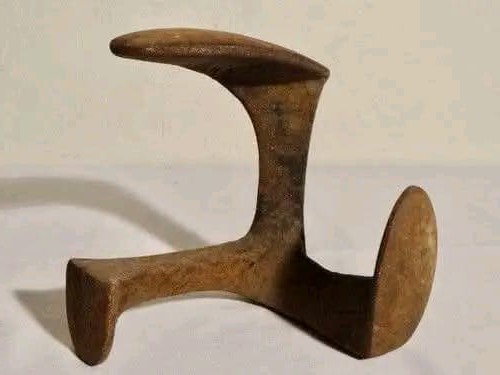The Cobbler’s Helper: A Look Back at the Vintage Shoe Last Stand

ADVERTISEMENT
The Cobbler’s Helper: A Look Back at the Vintage Shoe Last Stand
👞 Introduction
In the age of fast fashion and mass production, few of us stop to consider the artistry and labor that once went into something as simple as a pair of shoes. But back when every boot or loafer was handmade, tools like this wooden artifact—known as a shoe last stand or cobbler’s anvil—were at the heart of shoemaking and repair. To many today, this object may look like an abstract sculpture, but in reality, it was once a craftsman’s trusted companion, used daily in the humble workshop of the village cobbler.
🧰 The Purpose Behind the Form
The three-pronged design of this solid, weighty tool was not just functional—it was brilliant. Each curved surface of the stand represented a different size or shape of a foot or shoe, allowing the cobbler to work on everything from men’s boots to children’s slippers. The stand was typically made of iron or hardwood and was anchored firmly to a bench or floor so the cobbler could hammer, shape, and repair shoes against it.
Placed sole-up over the last, a shoe could be stretched, stitched, resoled, or nailed back to life. Long before modern adhesives and automated machinery, this stand was where leather was molded and soles were secured with the rhythmic sound of hammer taps echoing through the shop.
🧵 A Symbol of Craftsmanship
This tool represented more than utility—it was a symbol of honest, skilled labor. The cobbler’s hands worked tirelessly with it, knowing exactly how to position a shoe just right for mending. Shoes were precious, repaired repeatedly rather than thrown away. In those days, each item was valued, and every repair meant extending the life of something lovingly worn.
These stands were passed down through generations of craftsmen and often bore the marks of use: softened edges, worn curves, the darkened patina of age and sweat. They were a part of a cobbler’s identity, unique as a fingerprint in the trade.
ADVERTISEMENT
🔚 Conclusion
This shoe last stand is a reminder of a time when durability mattered more than speed, and when repairing something was more honorable than replacing it. It stands as a quiet tribute to the hardworking hands that shaped the soles of a thousand journeys. As we look back on tools like these, we are reminded not only of the evolution of industry—but also of the deep-rooted pride that once came with every stitch, every nail, every pair of shoes brought back to life.
So next time you lace up your shoes, take a moment to appreciate the generations of craftsmanship that came before—and the silent, sturdy tools that made it all possible.




